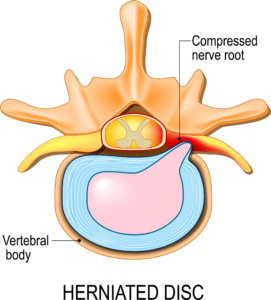Microdiscectomy and Foraminotomy
What is a Microdiscectomy?
Microdiscectomy and Foraminotomy are used to treat a condition involving a herniated disc and pinched spinal nerves caused by disc degeneration. The procedure can be performed anywhere along the spine, from the neck (cervical spine) to the lower back (lumbar spine).
During a microdiscectomy, the surgeon makes a tiny incision, using a microscope or magnifying instrument to view the disc and nerves, and removes disc material so that it no longer irritates and compresses the nerve root. During a foraminotomy, bone is removed in an effort to enlarge the “neural foramen,” the space between vertebrae where the nerve root exits the spinal canal.
A microdiscectomy is performed through the back, so the patient lies face down on the operating table for the surgery. General anesthesia is used, and the procedure usually takes about one to two hours.
What is a slipped disc?
A slipped disc in the back, also known as a herniated disc, occurs when a disc in your spine bulges, ruptures or ‘slips’ outwards and puts pressure on a nearby spinal nerve.The spine is made up of vertebrae that stack on top of each other, and in between each of these pairings is a spinal disc to act as a cushion between each bone. They’re made up of a tough outer wall and a softer inner nucleus. The nucleus is what pushes outward and can break through the outer wall, in which case the result will be painful and possibly debilitating. Microdiscectomy treats slipped discs to help relieve the pain and ongoing symptoms.
Microdiscectomy Success Rates
According to the Spine Institute of San Diego, a microdiscectomy procedure is up to 95 percent effective at eliminating sciatica pain caused by disc herniation. Sciatica is a pain condition caused by compression of the spinal nerve.
This compression is most often the result of a herniated lumbar disc. As the hernia develops and the damaged tissue extends into the spinal column, it pushes on the nerves. This causes the nerves to send pain signals to the brain. The pain is interpreted to be coming from the legs.
Most cases of sciatica will heal naturally without surgery in a few weeks. If the pain from sciatica lasts more than 12 weeks, you may benefit from a microdiscectomy.
Microdiscectomy Procedure
The goal of a microdiscectomy is to remove the disc material placing pressure on the nerves. The procedure is done under general anesthesia. You will be unconscious during the entire procedure and unable to feel anything. The procedure is performed with the patient lying face down. The process goes as follows:
A 1- to 1 1/2-inch incision will be made directly over the affected disc.
A lit microscope is used to help your surgeon see the affected area. The surgeon may remove a small portion of bone that protects the root nerve.
With a scissor-like tool, your surgeon will remove the damaged herniated tissue, relieving the pressure on the nerve.
The incision is closed with sutures.
The patient is usually discharged the same day or the next morning.
The spinal nerve now has the space it needs inside the spinal column, so any pain caused by pinching on the nerve should stop.
 Surgery for Herniated Discs
Surgery for Herniated Discs
Microdiscectomy is a leading procedure when dealing with lumbar herniated discs and cervical herniated discs. As noted previously, the nature of the procedures relieve pressure from the nerves and also the pain you experience from having a pinched nerve. The small portion pressing on this nerve is removed, and the majority of your disc is intact. The reason it’s called a ‘micro’ discectomy is because the incisions made are significantly smaller, and the procedure is aimed to be less invasive than an average discectomy.
Microdiscectomy Surgeons
Microdiscectomies are performed by orthopedic surgeons or neurosurgeons. Orthopedics is a field dedicated to treating the musculoskeletal system which is made up by the bones, joints, ligaments, tendons and muscles. Part of this system includes the spine, so an orthopedic surgeon is trained to deal with spinal issues and perform procedures like a microdiscectomy. Neurosurgeons specialize in dealing with conditions of the brain, spine and nervous system. Due to being experts in the nervous system, neurosurgeons do more than just perform surgery, they can help evaluate and rehabilitate people with neurological conditions as well. However, they are highly trained and skilled in performing spinal surgeries including microdiscectomy.
What are the risks of Microdiscectomy?
Microdiscectomy is a generally successful procedure with effective results in most patients. There are risks associated with any surgery, however. A dural tear, or a cerebrospinal fluid leak, happens in 1% to 7% of microdiscectomy operations, but won’t change the outcome of the surgery. If this happens the patient will have to restrict movement and lay down for a day or two after surgery to allow the leak to seal. Though uncommon, other risks and complications include nerve root damage, incontinence, bleeding, infection, deep vein thrombosis, and pain persisting after surgery.
What to expect after a Microdiscectomy?
After any surgery the post-operative care is crucial to prevent infection and injury. You’ll need to replace dressing 48 hours after the surgery, and avoid showering for 3 days afterwards, keeping the bandages dry while doing so. If the incision gets red, swollen, warm or begins draining you should contact your doctor as it may be a sign of infection. Exercise is a critical part of recovery, and should be a minimum of 30 minutes each day of casual walking. The pain experienced varies from patient to patient, pain at the incision location is normal and if the location of the microdiscectomy is in the lumbar region of the spine, you may have some leg pain.
How long is the recovery from Microdiscectomy?
Due to the less invasive process of a microdiscectomy most patients return to work and regular life in one to three weeks. The recovery process can be assisted by physical therapy, and if pain is persistent some pain medication may be prescribed for pain management. The quick recovery is another great benefit to microdiscectomy, since other spine surgeries such as spinal fusion can take months to recover from.
Discectomy in Atlanta
AllSpine offers microdiscectomy and foraminotomy procedures to Atlanta residents and the surrounding areas. We have five locations for your convenience with open MRI machines in house. Along with discectomy surgeries, we also have and offer laser spine surgery, laminotomys, epidural steroid injections and more. Our neurosurgeons and pain management doctors have decades of experience and thousands of successful patient operations completed. Book your appointment now or call 770-997-0600 to talk to a medical professional about back pain or neck pain.


